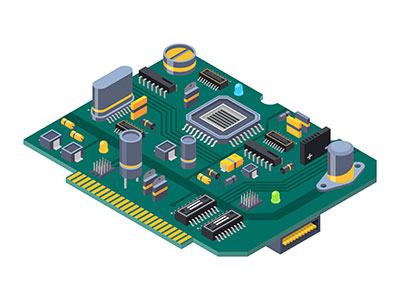Contents
Semiconductor Devises Diodes
A diode is the simplest form of semiconductor devices consisting of two pieces of different semiconductor materials called P and N. It is usually used to allow electric flow in one direction and limit it in the opposite direction.
When the P-type and N the materials are fused, you form a PN Function. We need to do it in a clean environment in a cleanroom. When attaching materials with different conductivity, the negative electrons are attracted to the positive charges and form a kind of boundary at the junction. The other similar charges repelled away, leading to the formation of a depletion region in the intersection where the flow of electrons and positive charges are in equilibrium.
The design of the Asian diode can make it forward biased or reverse biased.
Semiconductor Devices–Forward Bias
If we connect the P side to forward flow, it’s called a forward bias, and electricity flows in the circuit.
Semiconductor Devices–Reverse Bias
In the reverse bias configuration, we connect the P side to a more negative voltage, and thus any incoming electrons are repelled. It blocks the flow of electricity in the circuit.
Semiconductor Devices–Application
Some common applications of diodes are listed below
1. Diode in Rectifiers
Diodes help in the design of various rectifier circuits to rectify power from AC to DC. Some basic types of rectifier circuits using diodes are:
1. Halfwave
2. Full-wave center-tapped
3. Full bridge
We rectify the current to DC by alternating the diode’s bias during each half cycle of the input AC. Additionally, a capacitor may be used in these circuits to avoid ripple effects.
The diode in Clipper Circuits
Clipping circuits help remove excessive noise from FM transmitters. Based on the type of diode configuration used, we can classify these circuits as:
1.Series Clipper
The diode is reverse biased during the positive half cycle of input voltage and forwards biased for the negative half circle.
1. Shunt Clipper
The diode acts as a switch in this circuit. It is forward biased during the positive half cycle and works conversely during the negative process.
The diode in Clamping Circuits
While clipper circuits remove peak values, a clamper circuit helps shift a peak signal to the desired level. It is also called a DC restorer or a level shifter. The types of clamping circuits are:
1. Positive diode configuration
Negative peaks are clamped to so that they fall to a zero level.
1. Negative diode configuration
Positive peaks are clamped and made to fall to a zero level.
The diode in Logic Gates
Logic gates are used to perform logical operations like AND, OR, NOT, NOR, XOR, etc. By applying the concept of low and high impedance states of a logic switch to the reverse and forward bias, diodes can construct all types of logic gates.
Logic 1 corresponds to high voltage and logic 0 to a low voltage. To construct a simple OR gate, you can use two diodes with switches. When both switches are open, the diodes are reverse biased, and the output voltage is zero. When one switch is closed, one diode becomes forward biased, and the output voltage will be high.
The diode in Reverse Current Protection Circuits
The diode can protect the circuit from the reverse polarity of the DC power supply. When the DC power connection is incorrect, reverse polarity happens, and a large collection of current could flow into the circuit and cause damage. A blocking diode on either side of the input can help avoid this problem as it will block the current supply when connected in series with the load. The diode will be forward biased for a proper connection and reverse biased for the wrong link.
The diode in Voltage Multiplier
When you cascade multiple diodes in a rectifier circuit, you can get an output DC voltage equal to the value of applied input voltage multiplied by the number of multipliers used.
V out = V in * multipliers
These circuits can be voltage doubler and multiplier. By combining a capacitor to the course, you can get an odd or even multiple input voltage as output.
Semiconductor Devises Transistors
Transistors are the precursors to many modern gadgets and electronic devices. They made signal amplification and switching circuits possible, making them an essential part of electronic devices.
Each transistor consists of three essential parts called the emitter, base, and collector. Some transistors may also have an additional substrate for connecting with the circuits.
We further classified according to the structure, material, or mechanism involved in the transistor.
1. Bipolar Junction transistors (NPN and PNP)
2. Field-effect transistors (JFET and MOSFET)
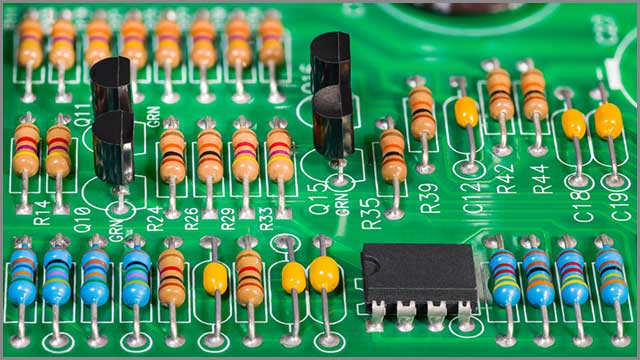
Applications
Transistors are used as switches and amplifiers in circuits to control the flow of current.
Bipolar Junction Transistors
Generally coined as junction transistors, BJT can further be differentiated based on the configuration.
1. In NPN circuits, the configuration is as CBE (Collector, Base, and Emitter).
2. In the case of PNP, it is EBC.
For NPN, connect two layers of N-doped material to the middle P-doped material. In this case, electrons pass from the emitter into the base, and the bottom controls the number of electrons the emitter can emit.
In the case of PNP circuits, the configuration is the opposite of NPN. Two P doped materials on the ends with an N doped material as the base. The base still controls current flows in the opposite direction, but.
Field-Effect Transistors
FET transistors work a little differently from BJTs. They consist of pins and have three parts, namely gate, source, and drain.
Junction FETs are a simpler version of FETs used as switches, amplifiers, and resistors. It does not need biasing current and works solely with the input voltage. They are available in two types, the P channel and the N channel.
1. P channel JFET
The current flow happens due to positive charges or holes.
2. N Channel JFET
Here, the electrons cause the current flow. These types of transistors are more popular compared to P channel transistors.
3. MOSFET
MOSFET stands for Metal Oxide Semiconductor Field Effect Transistor. It is the most popular type of transistor used in most low power circuits in chip designing technologies. As the name implies, this semiconductor device uses metal gate terminals and has four terminals-the drains, source, gate, body, or substrate.
MOSFETs offer high input impedance and low output impedance.
Semiconductor Devises Operational Amplifiers
Operational amplifiers are analog circuit blocks used to manufacture high-performance circuits with minimal components. Using a negative or positive feedback system, Amplifiers, capacitors, filters, etc. can use these circuits.
They are liners devices with properties similar to a DC amplifier.
An op-amp has three important terminals, inverting input, noon inverting input, and the output terminal, which can either sink or source current and voltage.
Applications
1. Compare Signals
Op Amps can compare voltage applied at one input end to the other input. Voltage differences in inputs can cause saturation in op-amp, and if both input voltages are of the same magnitude, the output voltage will be zero volts.
2. Buffer Signals
OpAmp configured with a negative feedback configuration acts as a unity gain buffer amplifier. It has high input impedance to avoid signal source loading problems, low output impedance, and high current gain.
3. Supply Dual Voltages
A dual supply op Amp can receive two different voltages, a positive and negative voltage. The non-inverting terminal receives a positive voltage, and the inverting terminal receives a negative voltage instead of being connected to the ground as in a single supply mode.
Dual supply op Amps are more suitable for AC signals and can work with higher voltage levels.
4. Amplify Signals
An op Amp can amplify input signals based on voltage in its non-inverting and inverting input terminals.
5. Filter Signals
A single op-amp can provide one, two, or three pole filters. Different variations can filter circuit using an operational amplifier. Some of them are:
1. Low pass filters
2. High pass filters
3. Bandpass filters
4. Notch filters
5. Summing Signals
The audio mixing circuit and the like need to use an operational amplifier for summing the voltage applied. The virtual earth summing point of the inverting amplifier circuit helps to sum up the audio inputs.
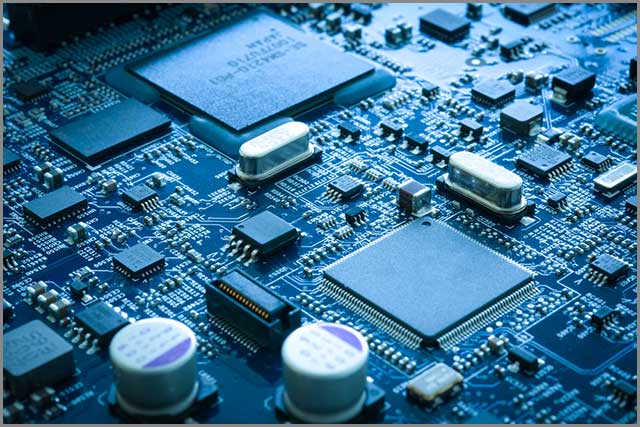
Semiconductor Devises Resistor
In electrical processes, we need resistors to control electrons’ flow and adjust the current level for a given voltage. Resistors help achieve this. The higher the resistance provided by a resistor, the lower the current flow will be.
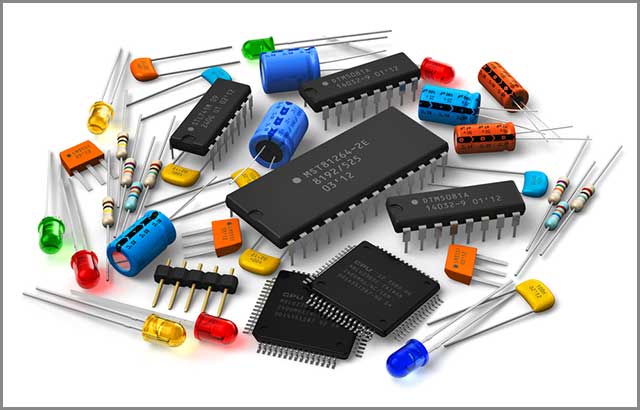
Applications
1. Transistors and LEDs
Resistors help protect the sensitive semiconductor devices like transistors and LEDs by allowing the right amount of current to pass through the circuits.
2. Timing and Frequency
Resistors, when connected to capacitors, can provide a time-controlled circuit device. It helps in the design of courses used for light flashes and sirens.
3. Voltage Divider
When connecting a daisy chain of resistors in a series circuit, you can get the desired voltage drop based on the resistors’ resistance value. The resulting voltage is a proportion of resistance contributed by each resistor in the circuit.
4. Resistors for Heating
Resistors are used in appliances like toasters, electric stoves, and heaters to convert electrical energy into heat energy.
Semiconductor Devises Capacitor
Capacitors are an essential part of all electronic circuits. They can get charged with current and can discharge it all at once.
Applications
1. Timing
By manipulating the charge and discharge time intervals, capacitors can use in time Dependant circuits like LEDs, loudspeaker systems, alarms, and courses that let out periodic beeps.
2. Smoothing
AC input current can be smoothened to produce a DC output using a capacitor and many household appliances.
3. Coupling
Capacitor coupling is the mechanism by which DC can block while letting AC alone pass through a circuit. Speakers use capacitors to achieve this mechanism, and we can avoid any damage caused by direct current.
4. Tuning
Variable capacitors are used in radio systems to tune circuits. It is done by connecting an LC oscillator to variable capacitors.
5. Energy Storage
Capacitors can store energy and release it at once, which finds use in applications like camera circuits where a sudden flash is required.
Semiconductor Devises Inductor
Inductors are passive electronic circuits that store energy in a magnetic field when current flows through it. The coil wound’s insulated wire around the central core makes the inductor, which is usually the largest component on the circuit.
Applications
1. Filters
Inductors can act as low pass filters, and when combined with capacitors and resistors, they can be used to create advanced filters in a circuit.
2. Sensors
Inductors can sense magnetic fields and magnetically permeable materials without having to be in physical contact with the said materials. It makes them excellent for use as sensors in traffic lights and similar applications.
3. Transformers
When inductors with the same magnetic path are combined, you can form a transformer. Transformers are an essential part of power grids and power supplies.
4. Motors
Inductive motors help convert electrical energy to mechanical energy more efficiently with the help of a magnetic force. We can use an induction motor with an AC input to generate a rotating magnetic field. Inductive motors also don’t require electrical contact between the rotor and machine, making it a safer and reliable choice.
5. Energy Storage
As long as the inductor is powered, they can store energy in the magnetic field. Switch-mode power supplies can use them, such as those used in personal computers.
6. Audio Equalizer
Audio equalizers are particular types of electronic devices that help in music production. They are used to enhance or cut certain frequencies to create the required sound effects.
There are different types of equalizers available, the most common being.
1. Shelving equalizer
2. Graphic equalizer
3. Parametric equalizer
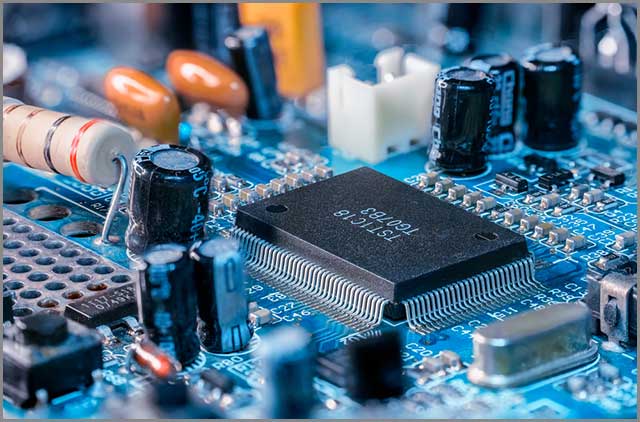
Summary
This article is a basic overview of semiconductors and all the devices that they can make.
Do you have any queries? Let us know in the comments below. If you need the services of Semiconductor Devices, you can contact us. WellPCB has more than ten years of experience in circuit board manufacturing. We can discuss it together and learn about electronics.
